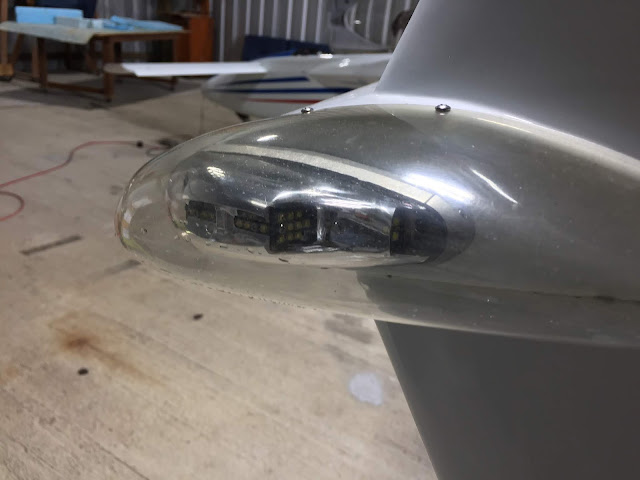Exterior lighting
The journey to convert JT from a VFR fun machine to a more all around worthy ride continues with a long overdue upgrade to the exterior this time.
“We are talking LED lights … Baby!”
 |
| Perhaps not these |
“But why”, you might ask?
“Hmmm… I see your point. Let’s take a step back for a moment.”
While owning JT (the flying EZ) has been a blast for the most part, she has been suffering from an intermittent strobe light. 😱
I know... strobe lights are supposed to be intermittent, this one however was intermittent in the sense that it would choose when to work and when not to work. Now, I am sure the strobe didn’t start acting up the day I bought the plane, so why hadn’t it been fixed?
In my opinion there were two reasons for this. One, the strobe power supply box cost around $550, and two, it resides in the ever inaccessible strake.
I struggled with this decision myself because reaching the power supply in the right strake would mean removing the right wing off of the airplane. If this sounds like a big deal, that’s exactly how I felt about it, even though in the past I had once helped my friend Walter to remove and reinstall his wings.
Last summer however, an unrelated maintenance task forced me to remove both wings (this will be the subject of a future post), so it became go-time for addressing the strobe light situation.
 |
| JT "naked" |
 |
| Wheelen lights/strobe power supply mounted in the right strake |
 |
| A close up of the boat anchor |
 |
| JT's original lights |
As you gathered by now, I decided to get rid of the existing Wheelen system, and upgrade to the Wheelen Orion. While this doubled my bill, it did offer a few advantages, weight being one of them. Because it is so difficult to remove weight from these small planes, when given the opportunity to remove 2.1 pounds (953 gr) that far back in the CG range, one cannot pass on it.
 |
| Be careful choosing your LED lights, as some do not satisfy FAR 91.205 (c) night flight requirement |
Not requiring a power supply that could go bad, makes LEDs more reliable, but the cool factor was certainly another big reason. LEDs nav lights are so good looking I had been lusting over them for a long time.
If this was not enough, there is also no need for heavy shielded cables, and no issues with electromagnetic interference.
“Not convinced yet?”
“Wait, there is more!”
Power usage went from 7 amps down to 3 amps, and they have the same footprint as my previous ones, so no fiberglassing, no drilling… nothing!
“That’s it, I am sold!”
 |
| Old lights, 246 grams each. |
 |
| New lights, 241 grams each. |
Replacement was quick and easy, and though not strictly necessary, I reused one wire from the old system and connected left and right LEDs to each other so that the LED strobes would flash at the same time (it’s an optional feature).
As good looking as JT already is, she looks even sharper now.
But wait, there’s more!
JT's landing light is an absolutely beautiful 250W GE unit, but the amount of power it requires literally overwhelmes my electrical system, and causes the Low Voltage light to come on. Needless to say I have never used it much, even though I would have liked to.
Introducing the Teledyne Alphabeam plus…
 |
| Teledyne Alphabeam plus |
Though slightly heavier, the Alphabeam is a direct replacement for the GE light, uses only 45W for the same amount of illumination, and its whiter light makes it easier to see in the dark compared to the yellowish GE output.
 |
| Old GE light, 229 grams. |
 |
| Gained 172 grams, but also the ability to use it. |
 |
| Diameter is the same |
 |
| This LED light doesn't care which wire is positive and which wire is negative |
 |
| Reusing the original landing light bracket |
 |
| Used silicone to glue it in |
 |
| Silicone curing |
 |
| The new look |
 |
| Cut a piece off the old radio bracket... |
 |
| ... and pressed it into new service. |
 |
| Landing light in the deployed position |
 |
| Looking like ready for business |
 |
| "Now, that's what I'm talking about!" |
The thick and heavy landing light wires went straight into the trash, and were replaced by lighter gauge ones thanks to the diminished demand on the electrical system.
With the outside lighting under control, I shall soon be directing my attention inside the cockpit and passenger compartment in order to shed some light on that situation.





